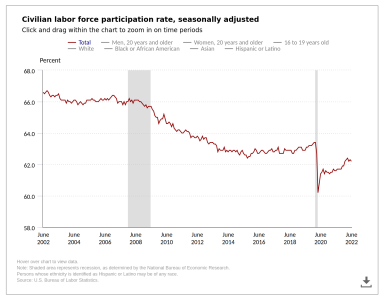I have seen this meme going around, and I share the hearty chuckle. However, newspaper columnists can write whatever they want, and you can find any given take in any given year if you search hard enough. The thing about "willingness to work" is that we have actual data on this: In the US, for example, the government publishes a statistic called the workforce participation rate:
View attachment 88909
As you can see, workforce participation
did decline during the pandemic, and while it has recovered, it hasn't recovered all the way. And this is at the tail end of what was already a long period of declining workforce participation.
One can argue that the workforce participation rate is an imperfect indicator of will to work, but I would be willing to bet that any other indicator you can come up with will show a similar long-term trend.
Now, it would be hasty to attribute the decline in people's workforce participation to mere laziness: it's true that a dollar doesn't go as far as it used to, and this can only deflate the willingness of people who were already on the margin to seek out a job. But it would be equally wrong to assume that the labor shortage is just "noise" drummed up by companies who want to offer people low wages. When inflation is high, like it is now, companies feel the cash crunch too, because all of the things they need to pay for in the course of their operations also get more expensive.
And contrary to popular belief, most companies don't just keep vast amounts of cash on reserve so that they can offer people competitive wages when the economy does the thing it just did. Shareholders would riot! A company with extra cash sitting around is a company that is shortchanging its investors.











